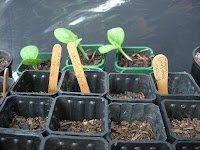Who are the Three Sisters?
“In late spring, we plant the corn and beans and squash. They're not just plants - we call them the three sisters. We plant them together, three kinds of seeds in one hill. They want to be together with each other, just as we Indians want to be together with each other. So long as the three sisters are with us we know we will never starve. The Creator sends them to us each year. We celebrate them now. We thank the Creator for the gifts given us today and every day.”Chief Louis Farmer (Onondaga)
The Three Sisters, corn, beans, and squash, are the traditional Native American garden foods of North America.
Each of the Three Sisters helps the others grow.
- Beans give nitrogen for the other sisters.
- Corn supports beans.
- Sprawling squash vines with prickly leaves protect from hungry animals, and hold in the
soil moisture on hot dry days.
The Three Sisters teach a sophisticated way to farm that evolved over generations of watchful farmers. Indigenous knowledge is the practical experience and living traditions of Native people passed on from generation to generation. Native American farmers observed that corn, beans and squash are stronger when grown together rather than separately. Why? Growing corn in straight rows wastes planting space, does not follow the natural contours of the Earth and requires heavy fertilization. Beans like a support system to hold on to. Squash and corn need
abundant nitrogen from the soil. Each of the three sisters has an important function. As corn grows straight and tall, beans cling onto the strong corn stalks for support. The broad prickly squash leaves hold in soil moisture and protect from marauding animals. The leguminous beans breathe in atmospheric nitrogen, absorbing it into the nitrogen-fixing nodules on their roots, and then give it to the soil to fertilize the other two hungry sisters.

Planting a Three Sisters Garden
In Spring when the oak leaves are the size of a deer’s ear - stand with two other friends in garden soil ready for planting. Clasp each other’s hands to make a circle together. Place your circle three people’s outstretched arms from other people’s circles. Everything in your circle is part of the Three Sisters garden. Look up to see the birds and bugs flying above your circle. Look down to the soil creatures crawling under the soil. All the life in the circle above and below is part of the Three Sisters Garden.
Make a hill of a hand height in the soil that is the same size circle as your arm-circle (about 2-3 feet
across). In the center plant seven corn kernels a hand apart in a circle. When the corn has grown as tall as your hands – plant beans a hand apart in a circle around the corn. Plant seven squash seeds around the edge of the circle. As the beans grow gently wind them around the corn. As the squash grows, guide them outside the circle.
Many Native American tribes honor the seven directions, Father Sky above, Mother Earth below, north, south, east, and west. Feel these directions with your feet firmly standing in this place. The seventh direction, the center of the circle, is in our heart.
Reprinted from 'From Generation to Generation' Fedenco Seeds Publication.





